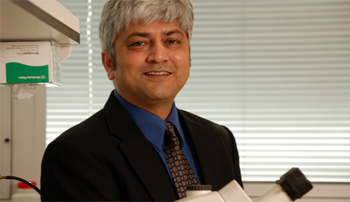 Adult stem cells within the retina may be chemically induced to regenerate photoreceptors and restore vision in people with conditions such as age-related macular degeneration (AMD) and retinitis pigmentosa (RP), a research study at UNMC shows.
Adult stem cells within the retina may be chemically induced to regenerate photoreceptors and restore vision in people with conditions such as age-related macular degeneration (AMD) and retinitis pigmentosa (RP), a research study at UNMC shows.
The research, which was done on mice and rats, is reported in the Aug. 26 edition of PLoS One.
The research represents the first indication that the retina can be repaired from within by its own cells. It would be a significant departure from transplantation of stem cells, which is now being studied for restoring lost vision and brings with it a variety of concerns such as immune rejection and the source of cells.
 |
Iqbal Ahmad, Ph.D. |
No current treatments
The degeneration of photoreceptors, cells in the retina that capture light, is the cause of vision loss in AMD and RP. Unfortunately, there is no treatment for photoreceptor degeneration.
Dr. Ahmad and his team, led by Carolina Del Debbio, Ph.D., a postdoctoral associate, have activated adult stem cells taken from the retina with a combination of chemicals and peptides.
Seeing the light
A small proportion of the activated stem cells migrated to the location of dying photoreceptors and differentiated into photoreceptor-like cells. An accompanying result was that rats that were chemically treated demonstrated a transient but significant improvement in light perception.
Preliminary results suggest that the improvement in light perception is likely due to the regeneration of photoreceptors, but further studies are needed to confirm it, Dr. Ahmad said.